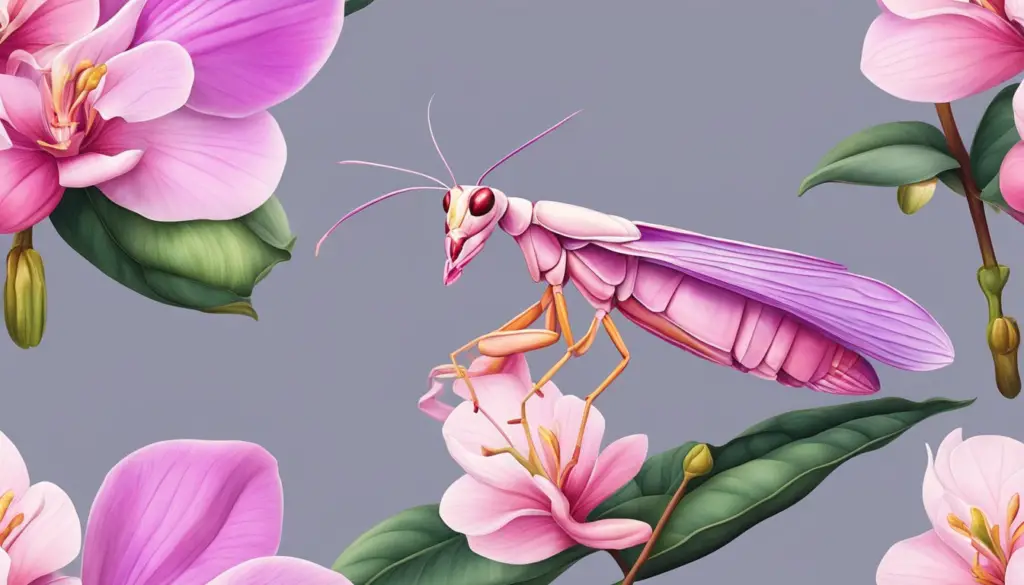The natural world is filled with amazing creatures, but few can rival the exquisite beauty of the Orchid Mantis (Hymenopus coronatus). With its delicate, petal-like appearance and impressive camouflage skills, this insect has captured the fascination of entomologists and nature lovers alike.
Native to Southeast Asia, the Orchid Mantis is often hailed as one of the most stunning examples of mimicry in the animal kingdom. This article explores the fascinating world of the Orchid Mantis, from its unique adaptations to its role in nature.
1. Master of Disguise: Camouflage and Mimicry
The Orchid Mantis is a true master of disguise. Its body is perfectly adapted to resemble the petals of an orchid flower, making it nearly invisible to both predators and prey. The insect’s pale pink and white coloring, along with its petal-like limbs, allow it to blend seamlessly into the vibrant tropical flowers of its environment. This ability to mimic the appearance of an orchid flower not only protects the mantis from predators but also helps it hunt.
Unlike other species of mantis that rely on speed to catch their prey, the Orchid Mantis uses its camouflage to ambush insects that are attracted to flowers, such as bees, butterflies, and flies. These unsuspecting insects are lured in by the mantis’s flower-like appearance, only to be swiftly caught and eaten.
How It Mimics Flowers:
- Color: Shades of white, pink, and purple to resemble orchid petals
- Shape: Leaf-like legs and a body that mimics the shape of flower petals
- Camouflage: Blends into tropical flowers, waiting for prey to come close
2. A Predator in Disguise
Despite its delicate and beautiful appearance, the Orchid Mantis is a formidable predator. It has evolved to catch prey by deception rather than speed. When insects are drawn to the flowers where the mantis hides, they don’t realize the flower itself is a hunter. As soon as prey comes within striking distance, the mantis uses its powerful front legs to grab it.
The Orchid Mantis has incredibly quick reflexes, and its legs are equipped with spines that help it hold onto struggling prey. Its powerful mandibles allow it to consume its meal quickly before returning to its motionless, camouflaged state. This ambush technique is highly efficient, as the mantis doesn’t have to expend energy chasing prey; it simply waits for the next insect to come along.
Hunting Strategy:
- Ambush predator: Waits motionless in flowers until prey comes close
- Striking Speed: Uses rapid reflexes to grab insects with its front legs
- Specialized Legs: Equipped with spines to hold onto prey
3. Incredible Adaptations for Survival
The Orchid Mantis’s beauty is not just for show—it is a vital part of its survival strategy. By mimicking flowers, the mantis can avoid predators while simultaneously hunting for food. But its camouflage isn’t the only adaptation that helps it survive. Orchid Mantises also have large, sharp eyes that give them excellent depth perception, allowing them to precisely judge when to strike at prey.
In addition to its visual acuity, the mantis can remain completely still for long periods, further enhancing its ability to remain undetected. Its long, raptorial forelegs are designed not only for grasping prey but also for quick, powerful movements, which are essential when capturing fast-flying insects like bees.
Adaptations:
- Camouflage: Perfectly mimics orchid flowers to avoid predators and lure prey
- Sharp Eyesight: Excellent depth perception for striking accurately
- Powerful Legs: Adapted for fast, efficient prey capture
4. Sexual Dimorphism: The Size Difference Between Males and Females
One of the most interesting aspects of the Orchid Mantis is the striking difference in size between males and females, a phenomenon known as sexual dimorphism. Female Orchid Mantises are significantly larger than males, with females reaching up to 4 inches in length, while males typically only grow to about 1 inch.
This size difference also leads to differences in behavior. Females are generally more aggressive hunters and have better-developed camouflage for their ambush tactics. Males, on the other hand, are smaller, more agile, and tend to be less conspicuous. Their main goal is to find mates, so they spend more time moving around and less time hunting.
Key Differences Between Males and Females:
- Size: Females are much larger (up to 4 inches) than males (around 1 inch)
- Behavior: Females are aggressive hunters, while males are more mobile
- Camouflage: Females are better camouflaged for ambush hunting
5. Orchid Mantis in the Ecosystem
Orchid Mantises play an important role in the ecosystems they inhabit. By preying on pollinators like bees and flies, they help control insect populations. Their presence in tropical gardens and forests helps maintain the balance between predator and prey, ensuring that insect populations do not grow too large.
However, their predation on pollinators also has an impact on plant reproduction. In areas where Orchid Mantises are particularly abundant, the loss of pollinating insects can affect the number of flowers that are successfully pollinated. Despite this, Orchid Mantises are generally seen as beneficial to their environments, as they keep the insect population in check and contribute to the overall biodiversity of their habitats.
Ecological Role:
- Predators of Pollinators: Help control populations of insects like bees and flies
- Impact on Plant Reproduction: Their predation can reduce pollination rates in some areas
- Biodiversity: Contribute to the balance of tropical ecosystems
6. Popularity in the Exotic Pet Trade
Due to their striking appearance and relatively easy care, Orchid Mantises have become popular in the exotic pet trade. Hobbyists and entomology enthusiasts are drawn to their beauty, and many keep them in terrariums that mimic their natural environment. Orchid Mantises are not aggressive toward humans and can be fascinating to observe as they go about their daily activities, from hunting to cleaning their delicate legs.
However, keeping an Orchid Mantis as a pet requires a proper understanding of its needs. These insects require a warm, humid environment with plenty of plants and hiding spots. They must be fed live prey, such as small insects, which allows them to exhibit their natural hunting behavior.
As Pets:
- Exotic Pet: Popular among insect enthusiasts due to their beauty
- Requirements: Need a warm, humid environment with live prey
- Behavior: Fascinating to watch as they hunt and mimic flowers
Conclusion
The Orchid Mantis is a true marvel of the insect world. Its extraordinary beauty, combined with its deadly hunting tactics, makes it one of nature’s most captivating creatures. From its flawless mimicry of orchid flowers to its role as a predator in tropical ecosystems, the Orchid Mantis demonstrates the incredible diversity and adaptability of life on Earth. Whether admired for its elegance or its impressive survival strategies, the Orchid Mantis is undoubtedly one of the world’s most fascinating insects.
FAQ
What is the Orchid Mantis?
The Orchid Mantis (Hymenopus coronatus) is a species of praying mantis native to Southeast Asia, known for its ability to mimic the appearance of orchid flowers to avoid predators and lure prey.
How does the Orchid Mantis hunt?
The Orchid Mantis uses its camouflage to blend into flowers and ambush insects that come near. It strikes with lightning speed, using its front legs to grab prey such as bees, butterflies, and flies.
Are Orchid Mantises dangerous to humans?
No, Orchid Mantises are not dangerous to humans. They do not have venom, and their bites are harmless.
Why are female Orchid Mantises larger than males?
Female Orchid Mantises are larger due to sexual dimorphism. This size difference allows females to be more effective hunters and better camouflaged, while males focus on finding mates.
Where can you find Orchid Mantises in the wild?
Orchid Mantises are found in the tropical forests of Southeast Asia, particularly in countries like Malaysia, Indonesia, and Thailand, where they inhabit areas with plenty of flowers and plant life.
Can Orchid Mantises be kept as pets?
Yes, Orchid Mantises are popular in the exotic pet trade, but they require specific care, including a warm, humid environment and live prey to feed on.


